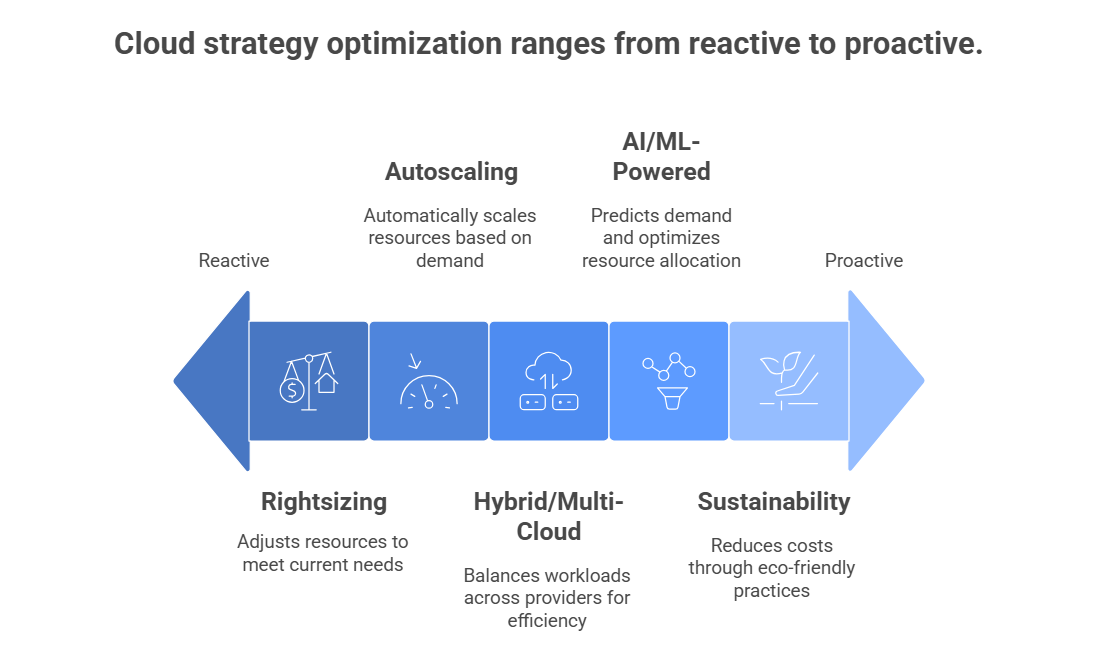Future-Proof Your Cloud Strategy: Cost Optimization Tactics for 2025’s Evolving Industries
Cloud computing is no longer optional it is the foundation of digital transformation in every industry. By 2025, organizations will spend half a trillion dollars every year on cloud infrastructure and services, as cloud is still the most powerful means to achieve agility, innovation, and scalability. But its accelerated adoption comes at a challenge: costs are growing more rapidly than expected.
Estimates indicate that almost a third of enterprise cloud expenditure is wasted because of overprovisioning, bad governance, and a lack of visibility. As businesses move towards AI, automation, and multi-cloud environments, cloud cost management has become a cost issue for the past, but now a strategic imperative. The question is not how to optimize cloud spend, but how to future-proof your cloud strategy for long-term success.
This is where cloud computing consulting becomes a critical function. Aligning fiscal prudence with technological ingenuity, consultancy specialists assist organizations in developing, deploying, and maintaining a robust plan that meets cost, performance, and security considerations.
Cloud Strategy Optimization Principles for 2025
AI/ML-Powered Predictive Management
Artificial Intelligence and Machine Learning are transforming cloud cost management. By leveraging predictive models, businesses can anticipate workload demand, scale resources dynamically, and prevent unexpected surges in spending.
Reinforcement learning models, for instance, are being deployed more and more to automatically decide the most effective resource allocation strategies. These smart systems examine past usage patterns and suggest changes, which usually lead to savings of 30–40% and increased utilization levels.
Rightsizing, Autoscaling & FinOps Discipline
Rightsizing is still one of the most efficient strategies for cloud cost optimization. Companies need to continuously keep an eye on workload demands and scale CPU, memory, and storage volumes to comply with real needs.
Autoscaling goes one step beyond by relying on automation to scale resources in and out at the moment, upon actual demand. With a FinOps culture having finance and engineering collaborate and share responsibility businesses are creating a practice that makes cloud expenditure predictable, clear, and maximized.
Hybrid and Multi-Cloud Interoperability
2025 has solidified the dominance of hybrid and multi-cloud strategies. Enterprises are no longer relying on a single provider; instead, they balance workloads across multiple vendors to maximize efficiency and resilience.
This model ensures flexibility organizations can shift workloads between providers for better pricing, compliance, or latency needs. However, interoperability challenges remain. Successful cloud computing consulting engagements focus on streamlining multi-cloud operations while embedding cost control measures at every layer.
Sustainability as a Cost Lever
Sustainability has moved from corporate social responsibility to cost strategy. Data centers are among the largest consumers of electricity globally, and energy prices directly impact cloud costs.
Green cloud initiatives such as using renewable energy, optimizing workloads for power efficiency, and deploying sustainable architectures can reduce both expenses and environmental footprint. By 2025, organizations that invest in eco-friendly cloud strategies not only lower bills but also position themselves for compliance with emerging environmental regulations.

Key Challenges in Cloud Cost Management
Even with awareness growing, several obstacles persist in 2025:
- Overprovisioning and idle resources: Many organizations still purchase more resources than needed, leaving virtual machines, databases, or storage unused.
- Shadow IT expansion: Teams frequently adopt SaaS applications without IT approval, making it difficult to track costs or ensure compliance.
- Complex pricing models: Cloud vendors constantly adjust their pricing tiers and discounts, creating confusion for enterprises managing multi-cloud environments.
- Security vs. cost balance: Businesses often overspend on compliance or under-invest in security, both of which can carry long-term costs.
- Data growth explosion: AI and IoT workloads are pushing data volumes to record levels, raising storage and transfer expenses.
These challenges emphasize why cloud strategy optimization is no longer a one-time exercise but a continuous discipline.
Enterprise Network for the Cloud Era
From Infrastructure to Intelligent Ecosystem
Traditional networks built for static infrastructure can no longer keep up with modern digital demands. Today’s enterprises require an Enterprise Network for the Cloud Era a flexible, automated, and intelligent ecosystem that supports hybrid and multi-cloud adoption.
This next-generation network integrates AI-powered automation, predictive analytics, and cloud-native design principles to ensure applications perform seamlessly while minimizing cost overheads. Businesses that adopt this approach experience stronger resilience against outages, better workload allocation, and reduced wastage through dynamic resource optimization.
Governance and Operational Resilience
Complexity of multi-cloud operations renders financial governance imperative. Most organizations are still battling fragmented visibility, which results in costs and compliance issues. Governance structures that incorporate cost accountability at all levels engineering, DevOps, and leadership are now the key.
For 2025, companies are embedding cloud cost management into the very DNA of operations. This includes proactive monitoring, detailed tagging policies, forecasting models, and real-time reporting dashboards. By establishing a cost-aware culture, organizations not only avoid overspending but also improve resilience against regulatory, financial, and operational risks.
Industry-Specific Cloud Cost Optimization Tactics
Healthcare
Medical professionals have to weigh compliance against cost. Tactics involve taking up secure cloud storage to ensure HIPAA compliance, automatic backups to mitigate redundancy, and predictive analytics for optimizing diagnostic workloads.
Financial Services
Insurers and banks value multi-cloud for resilience and compliance. They tend to negotiate with vendors, take up reserved instances for stable workloads, and take up advanced analytics to detect real-time fraud at the cost of minimizing compute expenses.
Manufacturing
Manufacturers use IoT and predictive maintenance powered by cloud. By optimizing data transfer policies and rightsizing analytics workloads, they lower costs while gaining real-time insights into supply chains and equipment performance.
Government & Public Sector
Public agencies prioritize shared services, governance through the center, and openness. Cost optimization guarantees that taxpayers’ funds are spent efficiently, while cloud-based solutions help deliver superior citizen services at reduced costs.
Tools and Technologies Enabling Cloud Cost Management
AI-Driven Optimization Platforms
Tools that use AI to detect anomalies, forecast demand, and recommend cost-saving actions are now mainstream. These platforms can automatically scale services or shut down idle resources without manual intervention.
FinOps platforms
Specialized FinOps tools assist companies in monitoring expenses, assigning costs by team or project, and establishing governance policies. They embed financial analysis into DevOps pipelines for enhanced accountability.
Cloud-Native Automation
Automation frameworks such as Infrastructure-as-Code, Kubernetes, and serverless architectures reduce manual oversight and improve efficiency, ensuring that cost optimization is embedded into development lifecycles.
Best Practices from Cloud Computing Consulting Experts
- Conduct regular cloud audits to identify underutilized resources.
- Implement cost allocation tags to track spending by department or project.
- Establish governance policies to curb shadow IT.
- Negotiate long-term vendor discounts, especially for predictable workloads.
- Foster a FinOps culture where cost awareness is shared across the organization.
These practices highlight why cloud computing consulting is invaluable. Consultants not only implement these strategies but also ensure organizations can sustain them over the long term.
Future Trends in Cloud Cost Optimization
Generative AI Workloads
AI is among the largest drivers of cloud adoption. Generative AI demands massive compute and storage capacity, compelling organizations to reconsider performance and affordability architectures.
Edge Computing Adoption
Edge computing lowers the cost of data movement by computing nearer the source. This transition decreases the load on centralized cloud resources while enhancing latency and cost savings.
Composable Enterprises
Businesses are embracing modular IT systems where resources are customized and scaled on demand. This approach provides precise cost management and future-proofing.
How to Choose the Right Consulting Partner
Not all consultants deliver the same value. The right partner should:
- Demonstrate proven expertise in cloud cost management.
- Offer multi-cloud and hybrid cloud experience.
- Provide compliance-aligned solutions for regulated industries.
- Share case studies that demonstrate measurable cost savings.
Final Thoughts
As industries evolve, cloud cost optimization is no longer about reducing bills it’s about ensuring resilience, agility, and long-term growth. Organizations that embrace predictive analytics, FinOps, sustainable infrastructure, and multi-cloud governance will lead their industries into the future.
App Maisters provides expert skills in cloud computing advisory, Cloud Strategy Optimization, and Cloud Cost Management. By overlaying fiscal responsibility with technical ingenuity, App Maisters enables business houses to craft cloud strategies that are not only economical but durable as well.
FAQs
What are the key cloud cost optimization strategies for 2025?
In 2025, cloud cost optimization focuses on AI-driven predictive management, rightsizing resources, autoscaling, and adopting a FinOps culture. By using tools like AI for workload forecasting and implementing real-time monitoring, businesses can significantly reduce unnecessary spending. App Maisters specializes in guiding companies through the process of cloud strategy optimization to ensure sustainable cost control and performance.
How can App Maisters help reduce cloud waste?
Cloud waste is often caused by overprovisioned resources or underutilized services. App Maisters helps businesses optimize cloud resources by using AI and machine learning for intelligent scaling, ensuring resources are allocated only when needed. Our team conducts regular audits, providing actionable insights that minimize waste and maximize efficiency.
Why is a multi-cloud strategy important for cost savings in 2025?
A multi-cloud strategy offers businesses flexibility to choose the best cloud provider for specific workloads, ensuring that no vendor locks or resource limitations drive up costs. By balancing workloads across multiple providers, companies can also ensure better cost performance and security compliance. App Maisters has deep expertise in optimizing multi-cloud environments to achieve optimal cost savings and resource efficiency.
What is FinOps, and how does it help in cloud cost management?
FinOps is the practice of aligning financial and operational teams to manage cloud costs effectively. It helps businesses track, allocate, and govern cloud spending while fostering accountability across departments. With App Maisters’ cloud computing consulting, we help integrate FinOps principles, enabling organizations to manage their budgets with precision and transparency, leading to significant cost savings.
How can AI and machine learning improve cloud cost optimization?
AI and machine learning help predict future demand and optimize resource allocation in real-time, reducing the chances of underutilization or over-provisioning. By analyzing historical data and automating decision-making, businesses can prevent cost overruns. App Maisters integrates these AI-powered tools into your cloud architecture, ensuring that your infrastructure scales dynamically and cost-effectively.
How do I achieve cloud cost optimization with App Maisters help?
Achieving cloud cost optimization requires a combination of strategies like predictive analytics, rightsizing, and the adoption of sustainable infrastructure. App Maisters offers a tailored approach, using cloud computing consulting to help businesses continuously monitor usage, implement cost-saving automation, and optimize workloads, ensuring maximum savings and performance.
How do sustainability goals affect cloud cost management in 2025?
Sustainability initiatives in cloud computing reduce costs by improving energy efficiency and aligning with green regulations. In 2025, organizations are integrating eco-friendly cloud practices to lower operational expenses while achieving environmental goals. App Maisters helps clients design energy-efficient cloud strategies that optimize costs while enhancing their sustainability efforts.




















